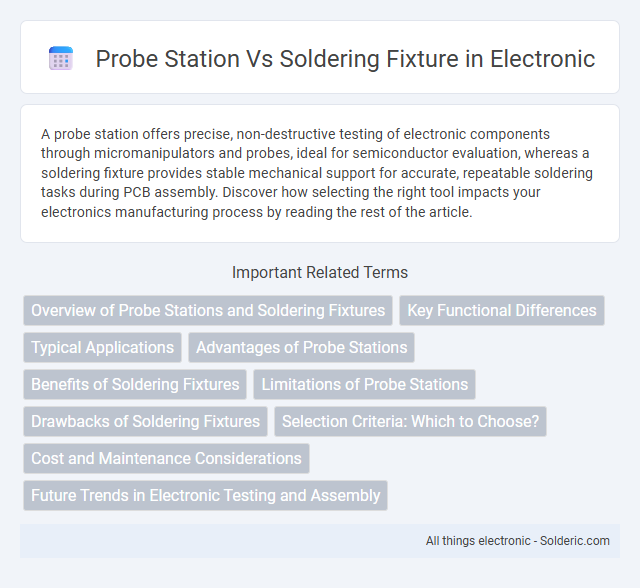A probe station offers precise, non-destructive testing of electronic components through micromanipulators and probes, ideal for semiconductor evaluation, whereas a soldering fixture provides stable mechanical support for accurate, repeatable soldering tasks during PCB assembly. Discover how selecting the right tool impacts your electronics manufacturing process by reading the rest of the article.
Comparison Table
| Feature | Probe Station | Soldering Fixture |
|---|---|---|
| Purpose | Testing and measurement of semiconductor devices | Holding PCBs or components for soldering |
| Primary Use | Electrical probing and signal analysis | Securely positioning for precise soldering |
| Precision | High precision with micromanipulators | Moderate precision, focused on stability |
| Typical Components | ICs, wafers, semiconductor dies | PCBs, small electronic components |
| Use Environment | Lab or R&D environments | Manufacturing and repair stations |
| Functionality | Non-destructive testing, signal probing | Provides mechanical support during soldering |
| Cost | Higher, due to advanced measurement tools | Lower, simpler mechanical design |
Overview of Probe Stations and Soldering Fixtures
Probe stations offer precise, non-destructive electrical testing for semiconductor wafers and electronic components, utilizing micromanipulators and microscopes to measure signals at microscopic points. Soldering fixtures provide stable and repeatable positioning of circuit boards or components during soldering processes, ensuring consistent thermal profiles and alignment for quality solder joints. Your choice between a probe station and a soldering fixture depends on whether you need detailed electrical characterization or reliable mechanical support during assembly.
Key Functional Differences
A probe station enables precise, non-destructive testing of semiconductor wafers and microelectronic devices by using micromanipulated probes for electrical contact, while a soldering fixture is designed to securely hold components and circuit boards in place during soldering processes, ensuring proper alignment and stability. The probe station emphasizes measurement accuracy and repeatable positioning without altering the device under test, whereas the soldering fixture facilitates physical assembly and thermal exposure necessary for permanent connections. These fundamental functional differences highlight the probe station's role in diagnostic evaluation versus the soldering fixture's application in manufacturing and repair.
Typical Applications
Probe stations are typically used in semiconductor testing, wafer-level inspection, and failure analysis to make precise electrical contact with micro-scale devices without causing damage. Soldering fixtures are commonly employed in electronics manufacturing for securely holding components in place during soldering processes, ensuring consistent thermal profiles and mechanical stability. Your choice depends on whether you require non-destructive probing for testing or a stable setup for soldering assembly tasks.
Advantages of Probe Stations
Probe stations offer precise, non-destructive testing and measurement of semiconductor devices, enabling accurate electrical characterization without damaging components. They provide high spatial resolution and flexibility for probing various die sizes and layouts, facilitating detailed analysis in R&D and failure diagnostics. Enhanced automation options in probe stations improve throughput and repeatability, boosting efficiency in wafer-level testing compared to soldering fixtures.
Benefits of Soldering Fixtures
Soldering fixtures provide precise alignment and secure holding of components during soldering, reducing errors and improving joint quality. They enhance production efficiency by enabling repeatable and consistent positioning, minimizing rework and assembly time. These fixtures also protect delicate parts from damage and ensure high reliability in complex or high-volume manufacturing processes.
Limitations of Probe Stations
Probe stations offer precise electrical testing for semiconductor devices but have notable limitations, including restricted mechanical stability and limited suitability for high-power or high-current measurements. They typically struggle with handling complex or large-scale circuit assemblies compared to soldering fixtures designed for robust mechanical support during permanent connections. Your choice depends on the testing scope, as probe stations may fall short in environments requiring strong physical contacts and durability under thermal stress.
Drawbacks of Soldering Fixtures
Soldering fixtures often present significant drawbacks such as limited flexibility, as they are typically designed for specific components, making them unsuitable for testing various device geometries. The process can be time-consuming and prone to thermal damage, which may affect the integrity of sensitive electronic parts. You may find probe stations more advantageous due to their non-destructive testing capabilities and adaptability for rapid device characterization.
Selection Criteria: Which to Choose?
When deciding between a probe station and a soldering fixture, consider precision and application needs: a probe station offers high-accuracy testing for complex circuits, ideal for detailed analysis and troubleshooting, while a soldering fixture provides stability and repeatability for mass assembly and rework tasks. Your choice should align with factors such as test point accessibility, volume of units, and the required level of automation. Evaluate the balance between flexibility in probing and throughput efficiency to optimize your device testing or assembly process.
Cost and Maintenance Considerations
Probe stations offer a higher initial investment due to precision components and automation capabilities, yet they reduce long-term maintenance costs by minimizing manual handling and wear. Soldering fixtures typically involve lower upfront costs but may incur increased maintenance expenses from frequent repairs, alignment adjustments, and potential damage during repetitive soldering processes. Evaluating cost-effectiveness hinges on production volume and precision needs, with probe stations favored for high-throughput, complex testing and soldering fixtures suited to smaller-scale or less intricate assembly tasks.
Future Trends in Electronic Testing and Assembly
Probe stations are evolving with enhanced automation and machine learning integration, enabling precise, high-throughput wafer-level testing critical for next-generation semiconductors. Soldering fixtures increasingly incorporate advanced temperature control and real-time process monitoring to improve reliability and consistency in surface-mount technology assembly. The shift toward smart manufacturing and Industry 4.0 drives convergence of these tools with IoT connectivity and data analytics for predictive maintenance and quality assurance.
Probe station vs soldering fixture Infographic

 solderic.com
solderic.com